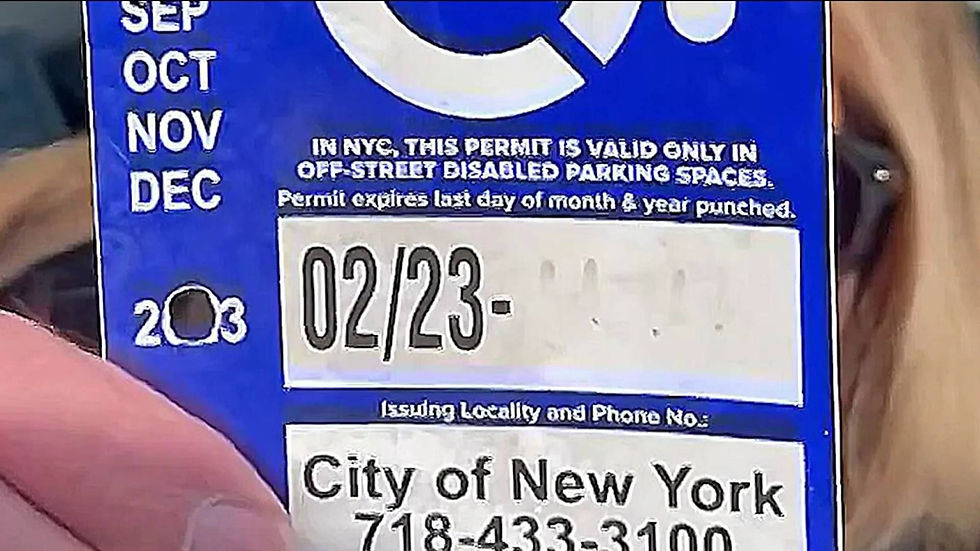How to Get a Disabled Parking Permit in New York
- gavobew426
- Sep 23, 2024
- 4 min read
Securing a disabled parking permit in New York is a relatively straightforward process designed to assist individuals with qualifying disabilities. This permit allows you to park in designated handicapped spots, providing easier access to important locations. If you're wondering how to apply, renew, or qualify for a disabled parking permit in New York, this guide will walk you through the essential steps. To discover How to Get a Disabled Parking Permit in New York follow the link.
Who Qualifies for a Disabled Parking Permit in New York?
Before applying for a permit, it's important to know if you meet the eligibility criteria. New York state issues disabled parking permits to individuals with medical conditions that severely impair their mobility. Qualifying conditions include:
Limited or no use of one or both legs.
Lung disease, requiring portable oxygen or respiratory assistance.
A cardiac condition classified by the American Heart Association as Class III or IV.
Limited mobility due to neurological, arthritic, or orthopedic conditions.
Legal blindness or severe visual impairments.
In addition to physical disabilities, temporary disabilities resulting from surgery or an injury may also qualify you for a short-term permit, which typically lasts for up to six months.

Step-by-Step Application Process for a Disabled Parking Permit in New York
Get a Medical Certification
To apply for a disabled parking permit, you must have a medical certification from a licensed physician or healthcare provider. This certification is essential, as it verifies your qualifying medical condition.
The medical professional will complete Part II of the "Application for a Parking Permit or License Plates for Persons with Severe Disabilities" (Form MV-664.1).
Obtain the Application Form
Download the application form (Form MV-664.1) from the New York Department of Motor Vehicles (DMV) website or pick it up at your local City Clerk’s office or DMV office.
Ensure that both you and your healthcare provider have filled out all the required sections of the form.
Submit the Application
Unlike other states, the New York State DMV does not issue disabled parking permits directly. In New York, disabled parking permits are issued by local municipalities. Therefore, you must submit your completed application form to your local City Clerk’s office, Town Hall, or other issuing agency.
Some municipalities allow you to submit your application by mail, while others may require you to submit it in person.
Receive Your Permit
Once your application has been reviewed and approved, you will receive your disabled parking permit. This permit comes in the form of a blue or red placard that should be hung on your rearview mirror when you park.
A blue placard is for permanent disabilities, while a red placard is issued for temporary disabilities. The permit is valid in any parking spot designated for disabled individuals, both on public streets and in private parking lots.
How Long is a Disabled Parking Permit Valid?
The length of validity for a disabled parking permit varies depending on whether you have a permanent or temporary disability. Typically:
Permanent Disability Permit: These permits usually last for up to five years and need to be renewed upon expiration.
Temporary Disability Permit: Temporary permits are issued for up to six months, depending on the expected duration of the disability as indicated by your doctor. If your condition persists, you may need to reapply.
Renewing your permit requires you to submit a new application with updated medical certification, particularly if your medical condition has changed.
Disabled License Plates in New York
In addition to a parking placard, individuals with qualifying disabilities may also apply for a disabled license plate. To apply for a disabled license plate, the process is similar to applying for a parking permit but includes additional documentation:
Complete Form MV-664.1: The same form used for a disabled parking permit.
Submit a completed Vehicle Registration/Title Application (MV-82).
Pay the appropriate fees: While parking placards are issued free of charge, disabled license plates may require standard registration fees.
Submit documents: You can apply for disabled plates by mailing the completed forms and documentation to your local DMV office or submitting them in person.
Benefits of a Disabled Parking Permit in New York
With a disabled parking permit, you can take advantage of several benefits:
Reserved Parking Spaces: You can park in spaces marked with the international symbol of accessibility, often located near building entrances.
Metered Parking Exemptions: In some municipalities, including New York City, you may be exempt from paying parking meters when displaying a valid disabled permit.
Time Limit Extensions: Some areas may offer extended time limits for parking when a disabled permit is displayed.
Important Considerations
While a disabled parking permit can make life easier for those with mobility challenges, it’s important to note that the permit is strictly for the person with the disability. It is illegal to use the placard if the person it was issued to is not in the vehicle, and doing so can result in significant fines or even the revocation of the permit.
Moreover, in New York City, having a state-issued disabled parking permit does not necessarily guarantee free parking in all areas. Certain high-traffic zones and private parking areas may still have restrictions, so always pay attention to signage.
Final Thoughts
Navigating the process of obtaining a disabled parking permit in New York might seem daunting, but with the right steps and documentation, it’s an accessible process. Be sure to follow your local regulations and stay updated on the renewal requirements to ensure continuous access to convenient parking solutions. This permit provides not just convenience, but a greater sense of independence for those with disabilities, helping them navigate the urban landscape with ease.



Comments